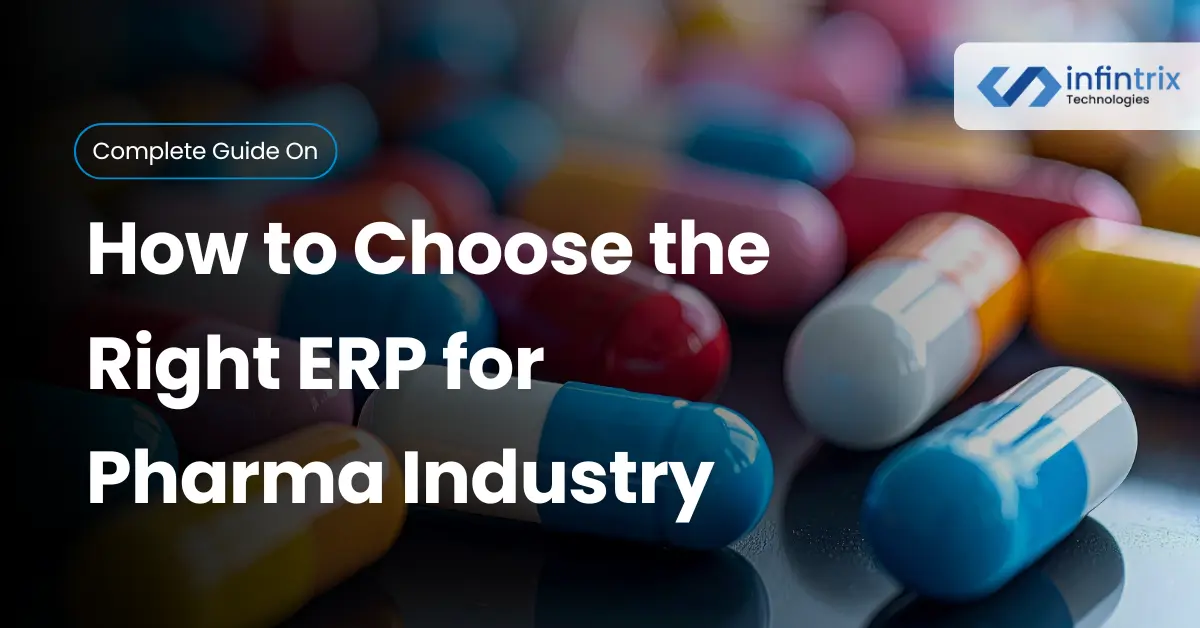You manage a pharmaceutical factory. Compliance deadlines loom. Batch traceability errors threaten recalls. Scaling production feels chaotic. The right pharma ERP software changes everything—it automates quality control, ensures FDA readiness, and streamlines your entire operation.
I've guided 50+ pharmaceutical manufacturing teams through ERP selection. This guide to pharma ERP for your factory cuts through the noise. You'll get a clear process for choosing an ERP for pharmaceutical manufacturing, must-have features of pharma ERP, and comparisons of top pharmaceutical ERP systems. Let's find the best pharma ERP software for your needs.
What Is Pharma ERP Software and Why Does It Matter?
Pharma ERP is specialized ERP software for the pharma industry. It integrates production, inventory, quality assurance (QA), and regulatory compliance into one system. Your factory gains real-time visibility across every process.
Generic ERPs can't handle pharma's unique demands. They miss batch management and cGMP tools. A true pharmaceutical factory ERP prevents errors and keeps you audit-ready.
Core Differences from Generic ERP Systems
Pharma ERP software prioritizes data integrity over basic accounting. Here's how it stands apart:
- Built-in validation vs. add-on compliance modules
- Batch genealogy vs. simple inventory tracking
- 21 CFR Part 11 audit trails vs. basic logging
- Serialization support vs. generic SKUs
Why Your Pharmaceutical Factory Needs Specialized ERP
Manual processes kill efficiency in pharmaceutical manufacturing. Spreadsheets create data silos. Quality control relies on memory. One expired batch can trigger massive recalls.
The best ERP for pharmaceutical manufacturing eliminates these risks. It automates standard operating procedures (SOPs). Your team focuses on production, not paperwork. Compliance becomes routine.
| Challenge | Without ERP | With Pharma ERP |
| Batch Traceability | Manual logs, 48+ hour recalls | Real-time lot tracking, hours to trace |
| Quality Control | Excel errors, missed inspections | Automated QMS, 40% fewer deviations |
| Expiry Management | Stockouts or waste | FIFO alerts, 25% less spoilage |
| FDA Audits | Weeks of prep | Instant audit trail reports |
Key Features to Look for in Pharma ERP Software
Focus on pharma ERP compliance requirements first. The best pharma ERP software handles FDA, cGMP, and 21 CFR Part 11 out of the box. It also streamlines daily operations.
Here are the five features of pharma ERP you can't compromise on. Each addresses specific pharmaceutical manufacturing pain points.
1. Regulatory Compliance (FDA, cGMP, 21 CFR Part 11)
Regulatory compliance protects your business. Look for audit trails that log every change with timestamps. Electronic signatures replace paper approvals.
This setup ensures data integrity. One client passed an unannounced FDA inspection because their ERP generated compliance reports instantly.
- 21 CFR Part 11 certified
- Automated validation documentation
- User access controls
2. Batch and Lot Traceability
Batch traceability defines modern pharma ERP. You need forward and backward tracing from raw materials to finished goods. Lot tracking and serialization prevent counterfeiting.
Test this in demos. Simulate a recall—good systems trace issues in minutes. Batch genealogy links every bill of materials (BOM) component.
- Complete batch management
- Serialization for global markets
- Multi-level BOM tracking
3. Quality Management System (QMS)
A strong QMS catches issues before they escalate. It handles deviations, CAPAs, and quality assurance workflows. Integration with lab systems saves hours.
Imagine a dashboard flagging non-conformances in real-time. Your quality control team responds instantly, not after shift end.
4. Formulation and Recipe Management
Formulation management secures your intellectual property. Lock recipes with version control. Scale batches without yield loss.
R&D teams love this feature. They test variations while production uses validated formulas. Pharmaceutical manufacturing stays precise.
- Recipe versioning and approval
- Yield optimization tracking
- Lab-to-production integration
5. Inventory and Expiry Date Management
Expiry date management prevents costly waste. Real-time inventory tracks FIFO automatically. Get alerts for nearing expirations.
Multi-location factories need this most. One client cut inventory waste by 28% in six months. Supply chain management (SCM) forecasts demand accurately.
Top Pharma ERP Software Options Compared
The top pharmaceutical ERP systems vary by factory size and needs. Enterprise players like SAP S/4HANA handle global operations. Smaller factories thrive with ERPNext or Odoo. Pick based on your scale.
ERPNext for the pharmaceutical industry offers open-source flexibility. Odoo for pharma factory delivers modular growth. Both beat proprietary costs while meeting pharma ERP compliance requirements.
| ERP System | Best For | Key Strengths | Deployment | Factory Size |
| SAP S/4HANA | Enterprise | Supply chain management, 21 CFR Part 11 | Cloud/On-prem | Large |
| Oracle NetSuite | Mid-market | Quality control, analytics | Cloud | Mid |
| ERPNext | Cost-effective | Batch management, customizable | Cloud/Open | Small-Mid |
| Odoo | Agile growth | Inventory, modular | Cloud/Open | Small-Mid |
| Microsoft Dynamics 365 | MS ecosystem | QMS, AI forecasting | Cloud/On-prem | Mid-Large |
Step-by-Step Guide: How to Choose the Right ERP for Pharma Manufacturing
Choosing the right ERP starts with clarity. Map your pharmaceutical manufacturing gaps first. Then test vendors rigorously. This six-step process has guided dozens of factories to success.
Follow these steps to find your best ERP for pharmaceutical manufacturing. Skip any, and you'll regret it later.
- Map Your Pain Points – List compliance, traceability gaps. Interview production, QA, and warehouse teams.
- Define Must-Have Features – Prioritize pharma ERP compliance requirements. Rank batch traceability vs. reporting needs.
- Shortlist Vendors – Request FDA-validated demos from 3-5 options. Include ERPNext for pharma if budget-conscious.
- Test with Real Data – Simulate batch traceability using your formulas. Time recall scenarios.
- Evaluate Partners – Check pharmaceutical manufacturing references. Ask about support response times.
- Calculate ROI – Factor cost of the pharma ERP. Expect payback in 12-24 months through efficiency gains.
Common Mistakes to Avoid When Selecting Pharma ERP
Bad ERP choices cost factories millions. I've seen pharmaceutical factory ERP projects fail from simple oversights. Don't repeat these errors.
That said, smart factories dodge these pitfalls and deploy smoothly.
- Ignoring validation needs – Generic ERPs fail cGMP audits. Verify 21 CFR Part 11 certification upfront.
- Choosing the cheapest option – Low-cost means high customization later. Balance the total cost of ownership.
- Skipping user training – Operators reject complex interfaces. Test usability during demos.
- Overlooking data migration – Poor planning corrupts data integrity. Budget 20% of the project for cleanup.
- Poor partner selection – Weak implementers abandon you post-go-live. Check pharma experience.
Cost Considerations for Pharma ERP Implementation
Cost of pharma ERP shocks many owners. Initial licenses run $50K-$500K+. Implementation doubles that. But smart choices—like ERPNext for pharma—slash expenses dramatically.
Best ERP software for small pharmaceutical manufacturing unit favors cloud options. Here's the breakdown:
| Factory Size | Software Cost | Implementation | Annual Total |
| Small (<50 users) | $5K-$10K | $50K-$150K | $15K-$30K |
| Mid (50-200 users) | $10K-$50K | $200K-$600K | $40K-$100K |
| Large (200+ users) | $100K+ | $1M+ | $150K+ |
ERPNext and Odoo start under $100/user/month. Payback comes fast through inventory savings and compliance avoidance.
Implementation Best Practices for Smooth ERP Rollout
Pharmaceutical manufacturing ERP projects succeed with planning. Build cross-functional teams early. Test relentlessly. Cloud systems like Odoo for pharma factory deploy faster than on-premise.
These five practices ensure your factory hits the ground running:
- Form project team – Include production, QA, IT, and finance leads. Meet weekly.
- Phase rollout – Start with inventory and batch management. Add QMS later.
- Train early – Run hands-on sessions pre-go-live. Simulate FDA audits.
- Validate thoroughly – Document every test case. Regulators check this.
- Monitor KPIs – Track on-time delivery, deviation rates post-launch.
Conclusion — Making the Right Choice for Sustainable Growth
The best pharma ERP software aligns technology with your pharmaceutical manufacturing goals. It ensures compliance, powers quality control, and scales with growth. Don't chase features—solve your factory's real problems.
With its deep industry expertise, Infintrix Technologies continues to help pharmaceutical factories achieve operational excellence through tailored ERP solutions. Audit your systems today. Request targeted demos. Your factory's future depends on this decision.
Frequently Asked Questions:
What ERP systems are FDA 21 CFR Part 11 compliant?
SAP S/4HANA, Dynamics 365, NetSuite, and QAD certify compliance. ERPNext and Odoo are configured for it—validate during setup.
Best ERP software for a small pharmaceutical manufacturing unit?
ERPNext for the pharmaceutical industry wins for cost and customization. Handles batch traceability, formulation management under $100/user/month.
Choosing a pharma ERP with strong batch traceability?
Prioritize batch genealogy demos. BatchMaster ERP excels here, but Epicor Kinetic offers speed for mid-sized factories.
ERP software for managing pharmaceutical formulations and quality control?
Look for recipe locking and integrated QMS. ERPNext and Sage X3 handle both seamlessly.
Odoo for pharma factory vs ERPNext for the pharmaceutical industry?
Odoo suits modular growth. ERPNext offers deeper manufacturing customization. Both beat proprietary pricing.

